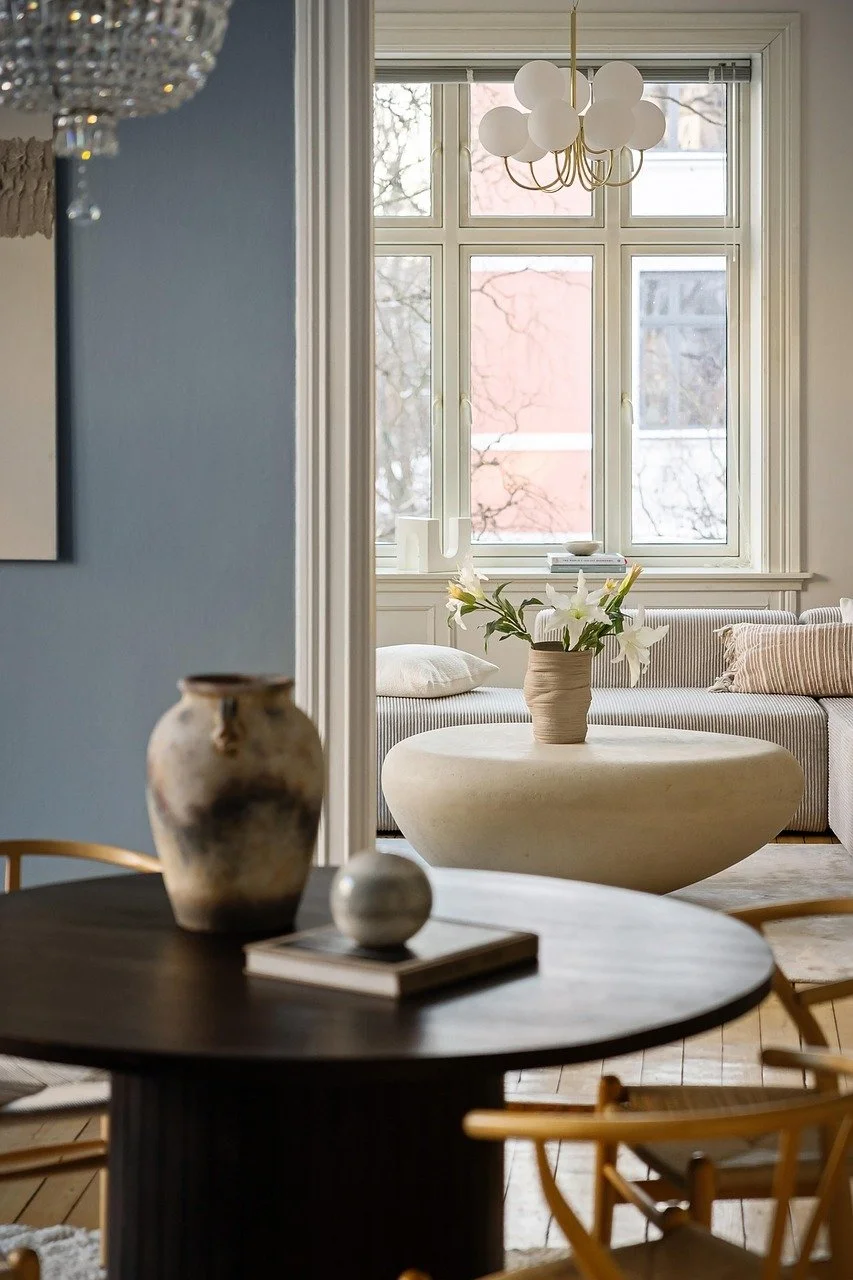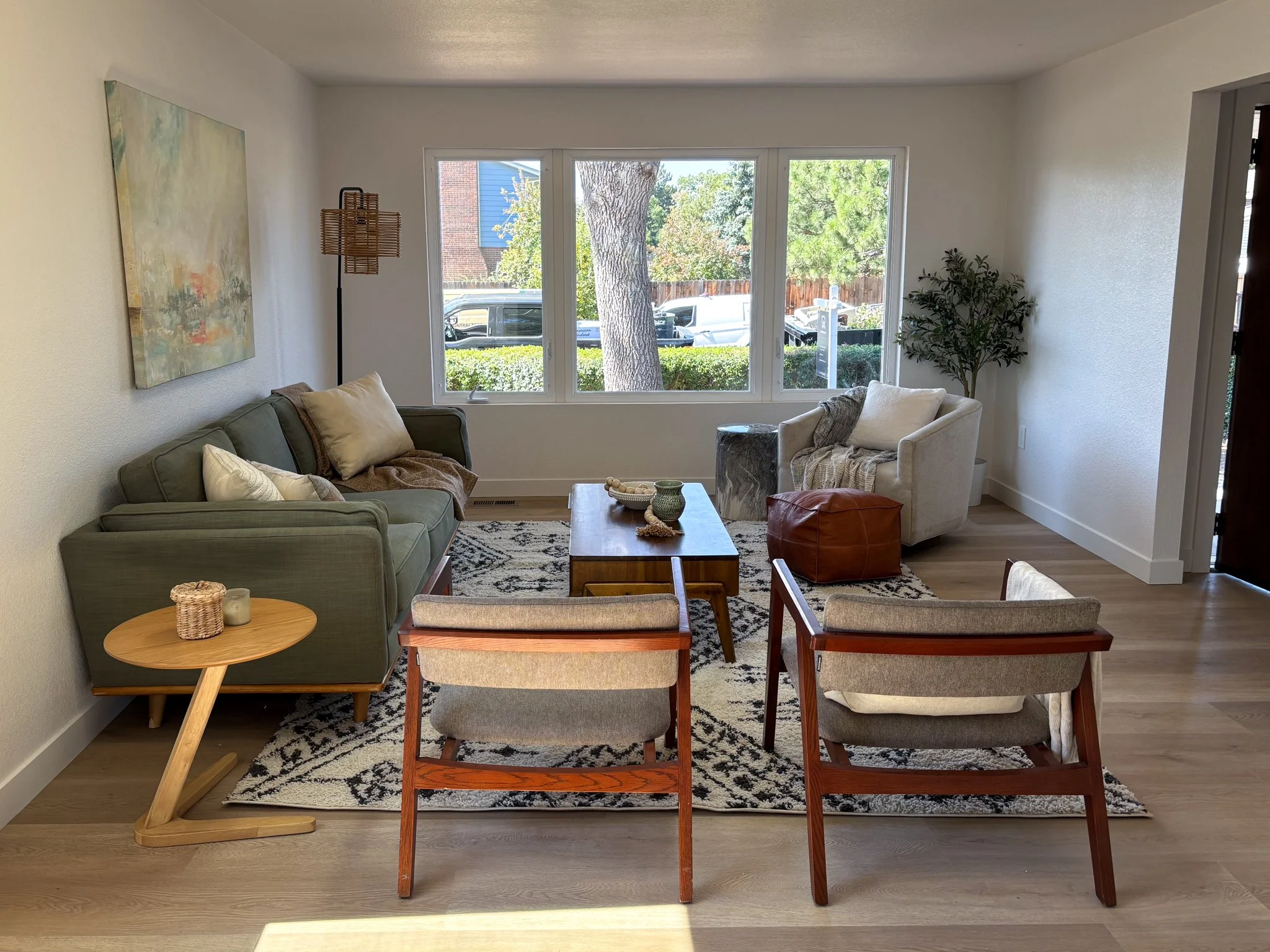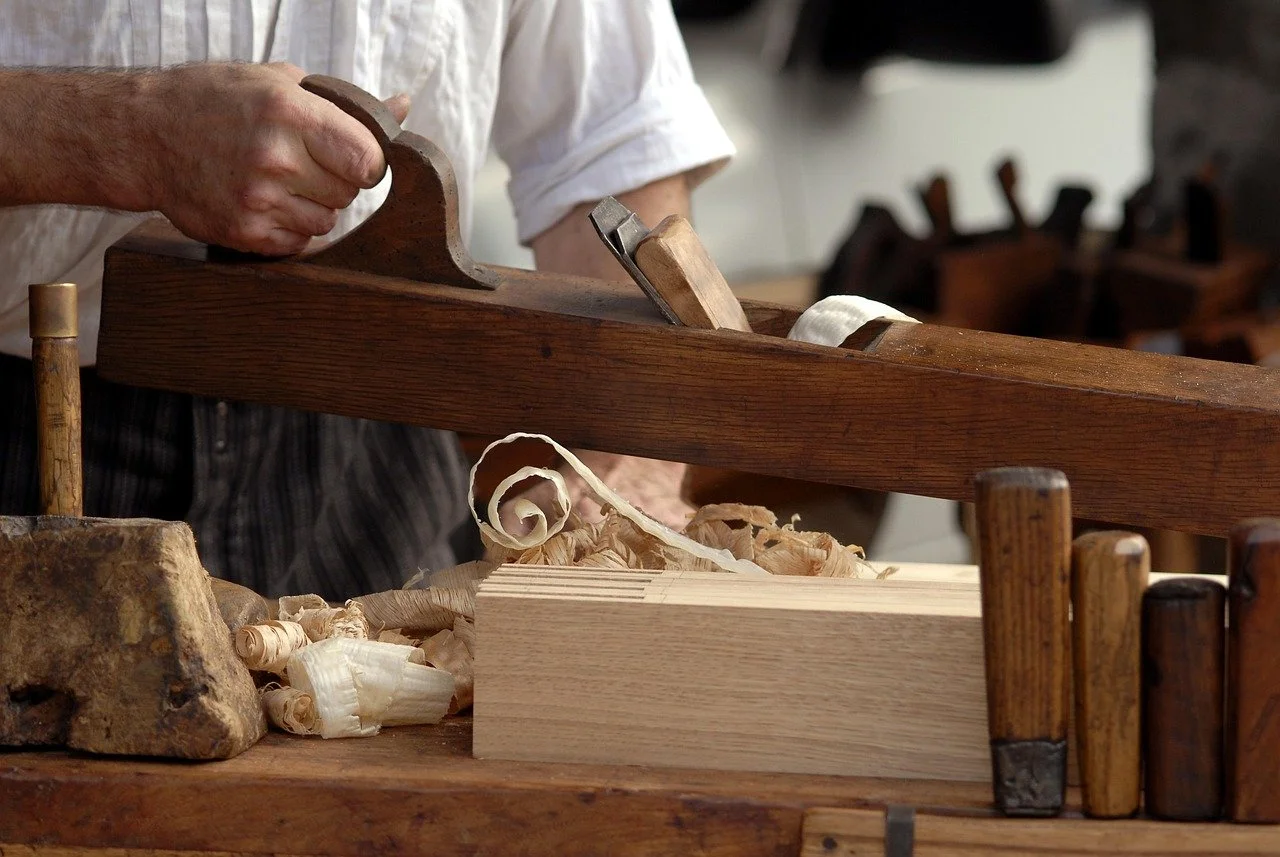Time to Slow Down
How to Bring Slow Decorating Practices Into the New Year
To quote the iconic Ferris Bueller, “Life moves pretty fast. If you don’t stop and look around once in a while, you could miss it.”
As I reflect on the past year, I can’t help but think of all the trends that have come and gone, seemingly in the blink of an eye. Your social media feeds have likely been filled with posts informing you of the decorating trends that are IN and OUT for 2025. Keeping track of what is on trend and what is “so last year” can be an endless task. Is the “wavy mirror” still trending? How long will the hype over color drenching last? I find it all exciting yet exhausting at the same time. I love a good trend and think it’s fun to incorporate them into designs in small ways—for example, through decor that can be easily and affordably switched out. Yet, when designing for clients, I fear creating a unified look that will be outdated in 2 years.
Dining table with sofa and coffee table in the background ©Pixabay
Time and Consideration
For these reasons, I was excited to learn more about the “slow decorating” movement – a design technique that has been talked about over the past few years. Akin to the slow fashion movement, slow decorating prioritizes honing our tastes and investing in good quality, timeless pieces. It means being mindful and intentional when decorating your home and investing in new furniture, leading to a well-curated and personal space.
This type of movement requires patience and introspection. Paula Sutton, of Hill House Vintage, explains that for her, being a slow decorator means “...I like to take time over my choices, and savour the stealth-like ‘hunt’ for each perfect addition over a period of time – sometimes even several years.”
Rather than purchasing a chair because it’s inexpensive, readily available, and in a trendy color, ask yourself if it’s something you’ll still want—and will hold up—in 10 years. Sometimes waiting on longer lead times and paying a little more (if that’s available to you) can result in a furniture piece that will be with you for years to come. I believe that spending more time and money on large foundational pieces and switching up your decor to suit your current style will be more sustainable and cost effective in the long run.
Living room with foundational furniture pieces, layered with decor. Photo by Allison Schoen
Because slow decorating is all about time and patience, it’s good to get your foundational pieces–sofa, bed, dining table–first, and focus on the extra pieces after. Achieving a personal, well-curated look begins with these pieces and gradually builds as you collect over time. Designer Ben Pentreath tells House and Garden, “I rely on people to live in their houses and collect. I provide a framework and, over time, rugs, paintings, and books can be added.”
“Taking time and consideration to mull over my choices is actually part of the enjoyment, I realise. Like a slow roast or an aged wine, the time spent waiting adds to the flavour for me, and leaves me with an interior that I love deeply and intensely and change infrequently.”
Sustainability
Slow decorating promotes sustainability through eco-conscious and local buying practices. Many designers have likened the slow decorating movement to the slow food movement – one that prioritizes local traditions and high-quality products.
By taking your time to search for the right furniture and decor, this technique offers a chance to support local small businesses and craftspeople. It’s also a way to find unique, high-quality pieces that you wouldn’t see anywhere else.
Woodworker artisan ©Pixabay
Why is shopping locally sustainable?
Without the demand to produce massive quantities, small businesses can implement premium materials and techniques. This results in pieces that will last much longer than those from mass-produced companies (who utilize particle board and veneers).
The frequent need to replace low-quality “fast design” items contributes to increased waste and use of natural resources.
While mass-produced products may be cheaper initially, frequent replacement can make them more expensive over time.
"When you buy an item that truly speaks to you, you’re much more likely to keep it longer and out of landfills—avoiding 'fast' furniture and design," Lauren Sullivan, a Tennessee-based interior designer, tells Martha Stewart. Similarly, buying vintage is another way to shop sustainably and find high-quality items. Vintage furniture and decor are often one-of-a-kind and full of character. Layering new and old pieces will give your home a thoughtfully curated, personal look. Plus, it’s so fun to check out your local flea markets and thrift stores!
Avoiding “fast design” at all costs isn’t the lesson here. It’s impossible to not incorporate any mass-produced items into your overall design. Sometimes you don’t have the luxury of time or money to buy a large, handmade piece of furniture from a small business. The lesson here is to thoughtfully incorporate both budget and splurge items into a cohesive design that is intentional, enjoyable, and will therefore last for many years.
Vanity table with a mix of new and thrifted items. Photo by Allison Schoen
“ When you buy an item that truly speaks to you, you’re much more likely to keep it longer and out of landfills—avoiding ‘fast’ furniture and design.”
Ongoing Process
I’ve been calling this way of decorating a “movement” because it’s a technique that can, and should, be ongoing throughout the years. Rather than a trend that comes and goes, slow decorating is a technique to help you build a foundational style which allows for change as trends and personal tastes shift over time.
Shelf with objects that are a mix of new, thrifted, and family heirlooms. Photo by Allison Schoen
Building an interior design look that reflects your personal style and evolves with your life isn’t exactly revolutionary. It’s not that slow decorating is a new movement you’ve never heard of. It’s simply a way to bring back intentionality and sustainability into our homes, in a time when trends and “fast-design” seem to constantly come and go.
I’ll leave you with this:
Be thoughtful in your design and purchasing. Really think about what styles bring you joy and continue to refine that over the years. Take your time to find the furniture pieces that you really love—the ones you’ll want to keep for many years. Once you have those foundational pieces, have fun with the accessories! Are you obsessed with purple basil right now? Why not add that pop of color into your home using throw pillows or bedding? You can easily change those out down the line.
Our homes should reflect our lives and personalities and be ever-evolving with us. Take off the pressure of having a perfect design right away. The best designs are built over time and unique to you. Bottom line: have patience, be intentional, and have fun with your interiors!
Sources
Johnston, Fiona McKenzie. “Why We Should All Be Slow Decorating.” House & Garden, Condé Nast Britain, 1 Jan. 2025, www.houseandgarden.co.uk/article/why-we-should-all-be-slow-decorating.
Sutton, Paula. “Paula Sutton on How to Find Joy in Decorating.” House & Garden, Condé Nast Britain, 18 Oct. 2022, www.houseandgarden.co.uk/gallery/paula-sutton-on-joyful-decorating.
Jones, Sally. “How to Embrace Slow Decorating, a Décor Trend That Encourages You to Create a Collected Look.” Martha Stewart, Dotdash Meredith, 17 May 2024, www.marthastewart.com/slow-decorating-8649006.
“Custom Furniture vs. Mass-Produced: What Is Right for You?” Heritage Amish Furniture, 14 Jan. 2025, heritageamishfurniture.com/custom-furniture-vs-mass-produced-what-is-right-for-you/#:~:text=A%20significant%20characteristic%20of%20mass,to%20moisture%20or%20daily%20use.
McGuirk, Kristina. “What Is Slow Decorating? The Sustainable Home Trend with Timeless Style.” Better Homes & Gardens, 5 Jan. 2022, www.bhg.com/decorating/lessons/expert-advice/slow-decorating-trend/.





